mNo edit summary |
|||
| (21 intermediate revisions by 4 users not shown) | |||
| Line 1: | Line 1: | ||
| + | [[File:Golem-cine2.jpg|thumb|A Golem]] |
||
| ⚫ | |||
| + | '''Golems''' are creatures that are animated from different elements. They appear frequently in the [[Diablo series|''Diablo'']] series. |
||
| + | ==Lore== |
||
| ⚫ | |||
| + | [[File:Flesh Golem.jpg|thumb|A Flesh Golem]] |
||
| − | There are four variations of the Golem in Diablo II. Low leveled necromancers can summon a [[Clay Golem]], which is a well rounded monster who can take good damage before its destruction. The [[Blood Golem]] is the second variation, which is a literal mass of blood and organs who's life is tapped directly into his master's, allowing him to transfer 75% of all [[life]] stolen to him, but to transfer some of the damage back too. |
||
| + | Golems can be summoned by the [[Priests of Rathma]]. While it is fairly simple for a [[Necromancer]] to [[necromancy|animate]] dead tissue, it is another matter entirely to instill the spark of life into inanimate objects.<ref name = "Arreat"/> Nonetheless, powerful necromancy can indeed bring golems into being. However, Golems are temporary constructs, and will quickly crumble into dust when their time runs out, or when they are destroyed in combat. Golems can likewise only follow simple directions from their creator. If ordered to attack their master's foes, they will simply attack the nearest enemy, then the nearest after that, and so on.<ref>''[[To Hell and Back]]''</ref> They will continue to attack until the Necromancer orders otherwise.<ref name = |
||
| + | "Rise">[https://us.battle.net/d3/en/rise-of-the-necromancer/ Rise of the Necromancer], ''Blizzard Entertainment''. Accessed on 2017-06-30</ref> Multiple Necromancers can combine their power to summon a single Golem.<Ref>2017-06-01, [https://www.youtube.com/watch?v=kC7CAv_eojE Necromancer Campaign Cinematic (Male)]. ''Blizzard Entertainment'', accessed on 2017-06-30</ref> |
||
| + | The tallest Golem ever summoned was created at the hands of Master Necromancer [[Maltorius]]. However, he lost his record after a spike at the top of the Golem was cut from it.<ref>''[[Diablo III]]'', ''[[Maltorius' Petrified Spike]]''</ref> |
||
| ⚫ | |||
| + | ===Golem Types=== |
||
| − | Having a golem servant is seen as the ultimate symbol of wisdom, but mostly that of the necromantic arts. Being able to create a creature from inanimate substances shows that a person is indeed in charge of the cycle of life, being able to bend it to the user's will. This is something Necromancers are quite hubrisly proud of. |
||
| + | [[File:Clay.png|thumb|A Necromancer with a Clay Golem]] |
||
| + | The [[Clay Golem]] is the simplest form of Golem; a servant directly from the earth to serve the Necromancer. The intense drain this places on the psyche of the caster only allows him to maintain a single Golem of any type at a time. |
||
| + | |||
| + | Variant types of Golem may be summoned by the priests. Through complicated arcane rituals and great mental concentration, a Necromancer can summon forth a [[Iron Golem|Golem]] from common base metals. The construct takes on the properties of the original source material, including any magical effects or other properties the original metal might have possessed. Additionally, by accelerating the particles of the air at an ever increasing pace, the Necromancer can force these particles to ignite, allowing a [[Fire Golem]] to appear seemingly out of thin air. |
||
| + | |||
| + | [[File:Blood Golem.jpg|thumb|A Blood Golem]] |
||
| + | [[Blood]] is a substance that has also been used in the creation of Golems. Utilizing a small quantity of their own blood, a Necromancer is able to give life to a creature neither living nor dead, yet formed of [[human]] tissue. This [[Blood Golem|homunculus]] gains nourishment from the fresh blood of its slain enemies, from which it replenishes its strength.<ref name = "Arreat">[http://classic.battle.net/diablo2exp/skills/necromancer-summoning.shtml Necromancer Summoning Skills], ''The Arreat Summit''. Accessed on 2017-05-19</ref> Similarly, [[Adria]] was able to raise [[Flesh Golem]]s through the use of [[blood magic]]. [[Flesh Gorger]]s were raised through a combination of earth, stone, and demon blood.<ref>''[[Diablo III]]'', ''[[Flesh Gorger]]''</ref> [[Flesh Hurler]]s were born from the water and earth of the [[Blood Marsh]],<ref>''[[Diablo III]]'', ''[[Flesh Hurler]]''</ref> while the [[Flesh Shaman]] was created through her own blood, and had mastery over [[fire]].<ref>''[[Diablo III]]'', ''[[Flesh Shaman]]''</ref> |
||
| + | |||
| + | Other types of Golems that can be summoned by Necromancers include the Bone Golem, Decay Golem, Flesh Golem, and Ice Golem.<ref>''[[Diablo III]]'', ''[[Command Golem]]''</ref> |
||
| + | |||
| + | ==In-game== |
||
| + | |||
| + | ===Diablo I=== |
||
| ⚫ | Golems were introduced in ''[[Diablo I]]'', where they could be summoned by using the {{1|Golem}} spell or an item with golem charges, like the [[Rod of Onan]]. There was only one type of golem in Diablo I. It was used most often by [[Sorcerer]]s as tanks and sometimes [[Rogue]]s with high [[magic (attribute)|magic]]. The Golems could not follow you downstairs and therefore self-destructed into clumps of rock as soon as you hit the stairwell. To train a Golem at level 1 required 81 magic. |
||
| + | |||
| + | ===Diablo II=== |
||
| ⚫ | |||
| + | |||
| + | There are four variations of the Golem in Diablo II. |
||
| + | *Low leveled necromancers can summon a [[Clay Golem]], which is a well rounded monster who can take good damage before its destruction. |
||
| + | *The [[Blood Golem]] is the second variation, which is a literal mass of blood and organs whose [[life]] is tapped directly into his master's, allowing him to heal master by attacking enemies. |
||
| + | *The third version is the [[Iron Golem]]. This version is strong and tough, and the Iron Golem's strength lies in his [[Thorns|Thorn]] Damage. This Golem is very powerful against Melee attackers. |
||
| ⚫ | |||
| + | |||
| + | You can only have one Golem of any type at any time. Once you summon a new Golem, the old one will immediately disappear. You do not need a monster corpse to summon Golems although the Iron Golem requires an [[item]]. Golems have a fixed [[defense]], but their Life and damage increase on Nightmare, and again on Hell Difficulty. |
||
| + | |||
| + | ===Diablo III=== |
||
| + | [[File:BoA_Golem.jpg|thumb|Golem in ''[[Book of Adria]]'']] |
||
| + | Only {{3|Necromancer}}s can use the [[Command Golem]] spell in ''[[Diablo III]]'' (type of the golem summoned depends on [[skill rune]]). The types include: Bone, Blood, Flesh (as well as Decaying and Flesh-Consuming) and Ice Golem (which is new to the series). Clay, Iron and Fire Golems do not make a comeback. |
||
| + | |||
| + | The [[Gargantuan]] skill fulfills a similar role for the [[Witch Doctor]]s. |
||
| + | |||
| + | Many monster types are also dubbed golems: |
||
| + | *[[Sand Dweller]]s were originally called ''Sand Golems'', but were changed to [[demons]] instead. However, some variations, like [[Eternal Guardian]]s, are specifically stated to be magically shaped. |
||
| + | *[[Flesh Golem]]s are [[Adria]]'s creations of blood and earth. |
||
| + | **[[Flesh Gorger]]s are massively raised from blood and clay. |
||
| + | **[[Flesh Hurler]]s are created with noxious swamp fumes, giving them poison infusion. |
||
| + | **[[Flesh Shaman]]s are made with the Witch's own blood, allowing them to use magic. |
||
| + | |||
| + | [[Half-formed Golem]] is a non-combat pet version of a Necromancer's Flesh Golem. |
||
| + | |||
| + | ==Trivia== |
||
| + | {{trivia}} |
||
| + | [[File:Golem-cine.jpg|thumb|250px|A Golem being created]] |
||
| + | *Golems (''Hebrew "Incomplete"'') originally come from [https://en.wikipedia.org/wiki/Golem Jewish folklore]. |
||
| + | |||
| + | ==References== |
||
| + | <references/> |
||
[[Category:Gameplay]] |
[[Category:Gameplay]] |
||
| + | [[Category:Minions]] |
||
Revision as of 11:17, 30 March 2019
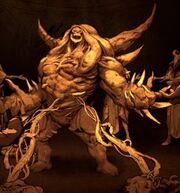
A Golem
Golems are creatures that are animated from different elements. They appear frequently in the Diablo series.
Lore
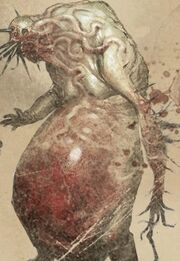
A Flesh Golem
Golems can be summoned by the Priests of Rathma. While it is fairly simple for a Necromancer to animate dead tissue, it is another matter entirely to instill the spark of life into inanimate objects.[1] Nonetheless, powerful necromancy can indeed bring golems into being. However, Golems are temporary constructs, and will quickly crumble into dust when their time runs out, or when they are destroyed in combat. Golems can likewise only follow simple directions from their creator. If ordered to attack their master's foes, they will simply attack the nearest enemy, then the nearest after that, and so on.[2] They will continue to attack until the Necromancer orders otherwise.[3] Multiple Necromancers can combine their power to summon a single Golem.[4]
The tallest Golem ever summoned was created at the hands of Master Necromancer Maltorius. However, he lost his record after a spike at the top of the Golem was cut from it.[5]
Golem Types
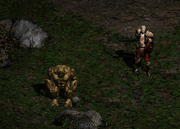
A Necromancer with a Clay Golem
The Clay Golem is the simplest form of Golem; a servant directly from the earth to serve the Necromancer. The intense drain this places on the psyche of the caster only allows him to maintain a single Golem of any type at a time.
Variant types of Golem may be summoned by the priests. Through complicated arcane rituals and great mental concentration, a Necromancer can summon forth a Golem from common base metals. The construct takes on the properties of the original source material, including any magical effects or other properties the original metal might have possessed. Additionally, by accelerating the particles of the air at an ever increasing pace, the Necromancer can force these particles to ignite, allowing a Fire Golem to appear seemingly out of thin air.
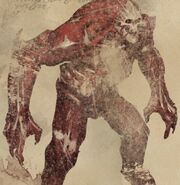
A Blood Golem
Blood is a substance that has also been used in the creation of Golems. Utilizing a small quantity of their own blood, a Necromancer is able to give life to a creature neither living nor dead, yet formed of human tissue. This homunculus gains nourishment from the fresh blood of its slain enemies, from which it replenishes its strength.[1] Similarly, Adria was able to raise Flesh Golems through the use of blood magic. Flesh Gorgers were raised through a combination of earth, stone, and demon blood.[6] Flesh Hurlers were born from the water and earth of the Blood Marsh,[7] while the Flesh Shaman was created through her own blood, and had mastery over fire.[8]
Other types of Golems that can be summoned by Necromancers include the Bone Golem, Decay Golem, Flesh Golem, and Ice Golem.[9]
In-game
Diablo I
Golems were introduced in Diablo I, where they could be summoned by using the Golem spell or an item with golem charges, like the Rod of Onan. There was only one type of golem in Diablo I. It was used most often by Sorcerers as tanks and sometimes Rogues with high magic. The Golems could not follow you downstairs and therefore self-destructed into clumps of rock as soon as you hit the stairwell. To train a Golem at level 1 required 81 magic.
Diablo II
The Golems were revamped in Diablo II, in which they could be summoned by the Necromancer as one of his minions.
There are four variations of the Golem in Diablo II.
- Low leveled necromancers can summon a Clay Golem, which is a well rounded monster who can take good damage before its destruction.
- The Blood Golem is the second variation, which is a literal mass of blood and organs whose life is tapped directly into his master's, allowing him to heal master by attacking enemies.
- The third version is the Iron Golem. This version is strong and tough, and the Iron Golem's strength lies in his Thorn Damage. This Golem is very powerful against Melee attackers.
- The final version is the Fire Golem, a entity of living flame. The Fire Golem causes massive fire splash damage similar to the Paladin's Holy Fire Aura, causing monsters in the area to passively burn.
You can only have one Golem of any type at any time. Once you summon a new Golem, the old one will immediately disappear. You do not need a monster corpse to summon Golems although the Iron Golem requires an item. Golems have a fixed defense, but their Life and damage increase on Nightmare, and again on Hell Difficulty.
Diablo III
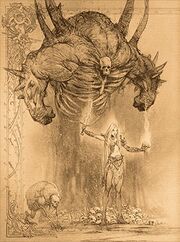
Golem in Book of Adria
Only Necromancers can use the Command Golem spell in Diablo III (type of the golem summoned depends on skill rune). The types include: Bone, Blood, Flesh (as well as Decaying and Flesh-Consuming) and Ice Golem (which is new to the series). Clay, Iron and Fire Golems do not make a comeback.
The Gargantuan skill fulfills a similar role for the Witch Doctors.
Many monster types are also dubbed golems:
- Sand Dwellers were originally called Sand Golems, but were changed to demons instead. However, some variations, like Eternal Guardians, are specifically stated to be magically shaped.
- Flesh Golems are Adria's creations of blood and earth.
- Flesh Gorgers are massively raised from blood and clay.
- Flesh Hurlers are created with noxious swamp fumes, giving them poison infusion.
- Flesh Shamans are made with the Witch's own blood, allowing them to use magic.
Half-formed Golem is a non-combat pet version of a Necromancer's Flesh Golem.
Trivia

A Golem being created
- Golems (Hebrew "Incomplete") originally come from Jewish folklore.
References
- ↑ 1.0 1.1 Necromancer Summoning Skills, The Arreat Summit. Accessed on 2017-05-19
- ↑ To Hell and Back
- ↑ Rise of the Necromancer, Blizzard Entertainment. Accessed on 2017-06-30
- ↑ 2017-06-01, Necromancer Campaign Cinematic (Male). Blizzard Entertainment, accessed on 2017-06-30
- ↑ Diablo III, Maltorius' Petrified Spike
- ↑ Diablo III, Flesh Gorger
- ↑ Diablo III, Flesh Hurler
- ↑ Diablo III, Flesh Shaman
- ↑ Diablo III, Command Golem
